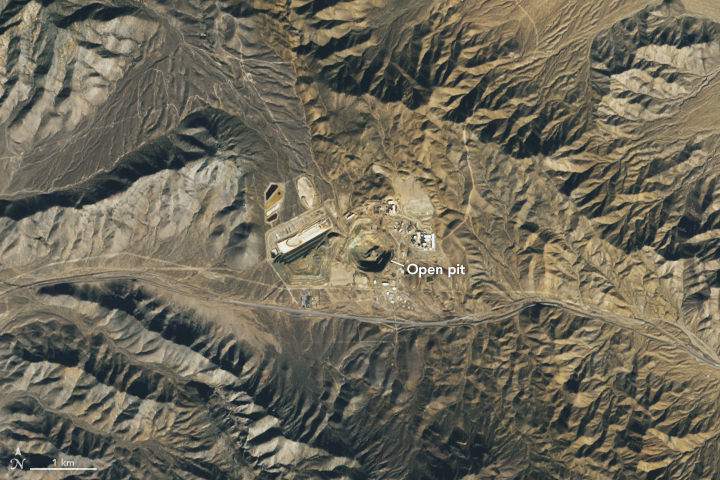
Mountain Pass Rare Earth Mine
Downloads
- mountainpassmine_oli_2022359_lrg.jpg (2751x1834, JPEG)
Metadata
- Sensor(s):
- Landsat 8 - OLI
- Data Date: December 25, 2022
- Visualization Date: March 13, 2023
The town of Mountain Pass, California, is home to the largest rare-earth element mine in the U.S. Its story began in the 1940s, when prospectors went searching for uranium.
This image shows Mountain Pass Mine, located in the Mojave Desert in southeastern California. The image was acquired on December 25, 2022, by the Operational Land Imager (OLI) on Landsat 8. The mine displays a gold color within an open-pit area that extends 800 meters (2,600 feet) across and more than 180 meters deep. Underlying the mine pit are carbonatite deposits that host bastnaesite—a major source of rare earth elements.
Discovery of the mine’s rare-earth elements happened by accident. In 1949, three prospectors sought uranium in the Clark Mountain Range in the midst of high demand for the element during the developing Cold War. However, instead of uranium, the prospectors struck bastnaesite, which contains rare-earth elements found in familiar gadgets we use today, such as the magnets in speakers, microphones, vibration monitors in mobile phones, and other modern communication devices.
Rare-earth elements (REE), or “rare earths,” are a select group of 17 chemical elements that are widely dispersed throughout Earth’s crust, but at low amounts. Compared to other mineral commodities, REEs are rarely found in concentrations abundant enough to be mined. REE mineral deposits are found in the eastern regions of the Mountain Pass landscape including: the Clark Mountain Range, Mescal Range, and the Ivanpah Mountains, which are bounded by several fault zones.
Below the surface of Mountain Pass Mine, a 1.7-billion-year-old carbonatite terrane from the Paleoproterozoic era stretches from Clark Mountain to the eastern Mescal Range. Carbonatite and alkaline magmas later intruded into the large carbonatite body and became the sites of REE mineralization.
The reason behind the genesis of the site’s REE deposit remains unknown. However, geologists from the U.S. Geological Survey are studying the relationship between the carbonatite and alkaline intrusions at Mountain Pass, which is essential for outlining other REE deposits in the area.
References & Resources
- Denton, K. M., et al. (2020) Geophysical characterization of a Proterozoic REE terrane at Mountain Pass, eastern Mojave Desert, California, USA. Geosphere, 16 (1), 456–471.
- JPL Photojournal (2011, April 6) PIA13979: Mountain Pass Mine, California. Accessed February 28, 2023.
- Minedat.org Mountain Pass Mine. Accessed February 28, 2023.
- Olson, J. C., et al. (1954) Rare-earth mineral deposits of the Mountain Pass District, San Bernardino County, California. Professional Paper 261.
- ScienceNews (2023, January 11) Rare earth mining may be key to our renewable energy future. But at what cost? Accessed February 28, 2023.
- Sci News (2020, January 7) Geologists Find Rare Earth Element-Bearing Rocks in Mojave Desert. Accessed February 28, 2023.
- U.S. Geological Survey (2023, January 26) Multidisciplinary Investigations of REE Mineralization at Mountain Pass and in the Southeast Mojave Desert, California. Accessed February 28, 2023.
- U.S. Geological Survey (2023) Rare Earths. Accessed February 28, 2023.
- U.S. Geological Survey (2022) Mountain Pass regional geologic map draped over topography. Accessed February 28, 2023.
- U.S. Geological Survey (2022, March 29) Mountain Pass REE mine in California. Accessed February 28, 2023.
- U.S. Geological Survey (2002, November 20) Rare-Earth Elements — Critical Resources for High Technology. Accessed February 28, 2023.
NASA Earth Observatory image by Allison Nussbaum, using Landsat data from the U.S. Geological Survey. Story by Tayler Gilmore.
This image record originally appeared on the Earth Observatory. Click here to view the full, original record.